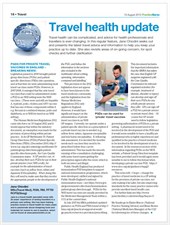
Prescribing for Travel Vaccines
CLICK to go back to FAQ menu
There are three ways a travel vaccine can be administered
1. under a PGD (Patient Group Direction)
2. under a PSD (Patient Specific Direction)
3. by a medical or non medical prescriber (using an FP10 [GP10 in Scotland] for an NHS vaccine and a private prescription if the vaccine is to be administered as an non NHS vaccine).
NOTE:
A key publication from the Royal Pharmaceutical Society published A Competency Framework for all Prescribers in September 2021 which became effective a year later. It is essential you are aware of and become familiar with this publication.
An article published in Practice Nursing in November 2022 ‘Best practice for medicines management and vaccination‘ is useful to read and has many helpful links to resources. You can download a PDF version of this article here
The NHS Specialist Pharmacy Service (SPS) – has a very comprehensive list of resources on PGDs HERE and PSDs HERE
Background information and use of PGDs
- Legislation passed in 2000 brought PGDs and PSDs into existence and at that time we were administering most travel vaccines under PGDs.
- However, during 2007/2008 it became clear that the only travel vaccines that could be given under a PGD in an NHS setting were the NHS vaccines. (These were and still are hepatitis A, typhoid, polio, cholera and ANY vaccine that has one of these disease protections within it e.g. Revaxis is combined tetanus, polio and diphtheria, so is NHS for travel in an NHS setting; also hepatitis A and B combined is provided as an NHS provision).
- From 2008 all private travel vaccines administered in an NHS setting had to be administered using a prescription or PSD which had to be signed before the vaccines were administered.
- Currently (2023) NHS travel vaccine template PGDs in England are prepared by UKHSA and can be found HERE (see section individuals at increased risk), however they cannot be used until signed off (in Section 2, usually found on page 4) by your local organisation that has the legal authority to authorise the PGD
- If working in an NHS General Practice and you have a query about your PGD you would need to direct your question to the Medicines Management Team of the local Integrated Care Board (ICB) in your region. Find your local ICB
- For a list of the UKHSA Health Protection Teams see here.
- NHS PGD templates for travel vaccines used in Scotland are HERE
What detail must be on a PSD?
A PSD, signed by a qualified, registered prescriber, at a minimum should specify:
- Name of patient and/or other individual patient identifiers
- Name, form and strength of medicine (generic or brand name where
- appropriate)
- Route of administration
- Dose
- Frequency
- Start and finish dates.
- Signature of prescriber
For further details see the MHRA archived information here and directly from the Specialist Pharmacy Service here
Giving Private Travel Vaccines under a PGD in an NHS setting
In September 2015 a new development regarding Private Travel Vaccines and the writing of PGDs in a GP surgery occurred – here is the detail
The Human Medicines Regulations 2012 came into force on 14th August 2012 and it would appear that within the statutory document, an exemption was made for the provision of prescribing within private practice. This information regarding the changes from 2012 does not appear to have been known by the travel medicine community but this now means that in England a PGD can now be used for the provision of private vaccines in this NHS setting
Where was the evidence?
The Care Quality Commission published guidance in their GP Mythbuster 19: Patient Group Directions (PGDs) / Patient Specific Directions (PSDs) published in December 2014 (updated December 2022) found HERE
In January 2016 the BMA published guidance on PGDs and PSDs, latest update September 2020, found HERE . The full guidance document is found and is downloadable at the bottom of this webpage.
What resources are there to help with PGD development?
In the resources section of the information regarding PGDs on the NICE website, a Patient Group Direction template has been provided and it would seem sensible to follow this format when developing a private vaccine PGD. See HERE
There are also considerable resources available on the SPS website – see HERE.
Other resources to help on the subject
Note, there is some repetition of a few resources here, incase you missed them above!
- Royal Pharmaceutical Society 2021 A Competency Framework for all Prescribers
- How long should a PGD be kept after it has expired (The same rules apply to PGD records as to all other patient records. For adults, all PGD documentation must be kept for eight years, and for children until the child is 25 years old, or for eight years after a child’s death.) – see HERE
- Nursing Associates, Physician Associates and the use of Patient Group Directions HERE
- UKHSA PGD templates HERE
- NHS Specialist Pharmacy Service – very comprehensive resources on PGDs HERE and again (as above) for PSDs HERE
- MHRA website on PGDs HERE
- NICE site for PGDs HERE
- NHS Health Education for England e Learning for Health course on PGDs HERE (free of charge to take)
- NaTHNaC Medicines Management resources for PGDs and other links HERE
- In August 2015 I wrote a travel health update in Practice Nurse Journal – please click HERE or on the image to the left below. Thanks go to Practice Nurse for allowing me to publish this article on my website. Thanks also to Elaine Biscoe (National Practice Nursing Advisor) and Brian Brown (National Medicines Manager) at the CQC for their help informing me of these changes.
- For the BMA guidance on PGDs and PSDs go the the website HERE
For the travel risk assessment and travel risk management forms see items no. 1 and 2 in TOOLS – click HERE. The travel risk management form has a sample PSD included within it.





